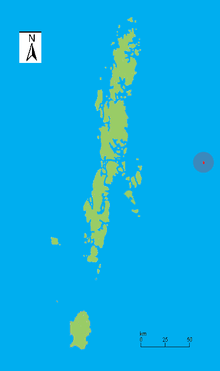Barren Island (Andaman Islands)
| Barren Island | |
|---|---|
 Barren Island erupting in 1995 | |
| Highest point | |
| Elevation | 354 m (1,161 ft) |
| Coordinates | 12°16′40″N 93°51′30″E / 12.27778°N 93.85833°ECoordinates: 12°16′40″N 93°51′30″E / 12.27778°N 93.85833°E |
| Geography | |
| Location | Andaman Islands, India |
| Geology | |
| Mountain type | Stratovolcano with pyroclastic cones |
| Last eruption | 2013 to 2015 (ongoing) |
Barren Island is located in the Andaman Sea, one of the most easterly island of the Andaman Islands. It is the only confirmed active volcano in South Asia. Along with the rest of the Andamans, it is a part of the Indian Union Territory of Andaman and Nicobar Islands, and lies about 135 km (84 mi) northeast of the territory's capital, Port Blair. The first recorded eruption of the volcano dates back to 1787. Since then, the volcano has erupted more than ten times, with the most recent one which started in September 2010 and continued through January 2011.[1]
After the first recorded eruption in 1787, further eruptions were recorded in 1789, 1795, 1803–04, and 1852. After nearly one and half century of dormancy, the island had another eruption in 1991 that lasted six months and caused considerable damage. There were eruptions in 1994–95 and 2005–07, the latter being considered to be linked to the 2004 Indian Ocean earthquake.[2]
Location

This volcanic island stands in the midst of a volcanic belt on the edge of the Indian and Burmese tectonic plates. Narcondum is a dormant volcano in the area, apart from volcanic seamounts like Alcock and Sewell.

All the historical and recent eruptions (1789 and after) are confined within and around an active polygenetic cinder cone in a 2 km (1.2 mi) wide caldera that was formed by the Pleistocene collapse of a primitive cone of a stratovolcano. The remnant of the primitive volcanic cone forms a precipitous cliff around the island (commonly referred as caldera wall), with a break towards the west. The highest elevation on the island is 354 m (1,161 ft), with most of the primitive volcano underwater (standing on the seafloor 2,250 metres (7,380 ft) below sea level). The island is 3 km (1.9 mi) in diameter, with a total surface area of 10 km2 (3.9 sq mi).[3]
True to its name, it is a barren area uninhabited by humans, though it has a small population of goats. Also birds, bats like flying foxes and a few rodent species such as rats are known to survive the harsh conditions.[4]
Scuba diving
The waters surrounding Barren Island are reputed to be among the world's top scuba diving destinations. Major attractions here are the crystal clear visibility, Manta Rays, interesting basalt formations, topography of past lava flows and fast growing coral gardens. This dive destination is remote but can be accessed by either a live aboard ship or with scuba-operators based at Havelock Island.
See also
References
- ↑ "Barren Island". Global Volcanism Program. Smithsonian Institution.
- ↑ Jørgen S. Aabech. "Barren Island, Andaman Islands, Indian Ocean". Retrieved June 2013.
- ↑ "Barren Island Volcano, Indian Ocean - facts & information". Volcanodiscovery.com. Retrieved June 2013.
- ↑ "Scientific Expedition to Barren Island (Andaman Islands, Indian Ocean)". 2003. Archived from the original on 4 February 2012. Retrieved June 2013.
External links
| Wikimedia Commons has media related to Barren Island (Andaman Islands). |
| Wikisource has the text of the 1911 Encyclopædia Britannica article Barren Island. |
- Geological Survey of India : THE BARREN ISLAND VOLCANO
- Department of Earth Sciences, IIT Bombay
- Bhaumik, Subir (11 July 2005). "Andamans volcano is post-tsunami hit". BBC News. Retrieved June 2013.